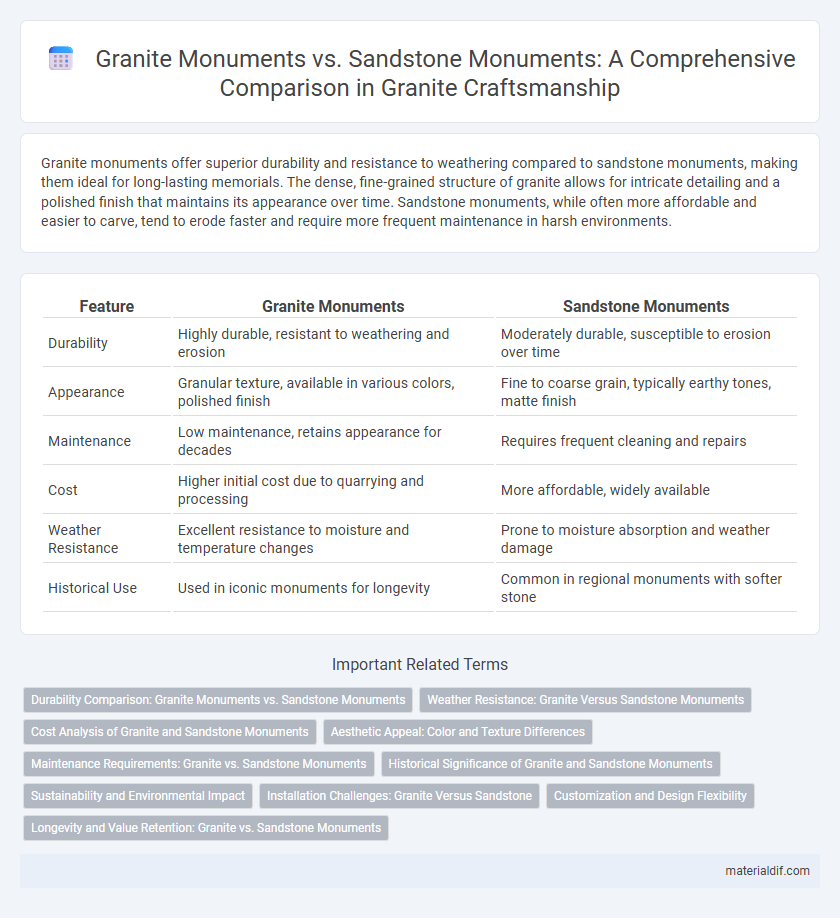Granite monuments offer superior durability and resistance to weathering compared to sandstone monuments, making them ideal for long-lasting memorials. The dense, fine-grained structure of granite allows for intricate detailing and a polished finish that maintains its appearance over time. Sandstone monuments, while often more affordable and easier to carve, tend to erode faster and require more frequent maintenance in harsh environments.
Table of Comparison
| Feature | Granite Monuments | Sandstone Monuments |
|---|---|---|
| Durability | Highly durable, resistant to weathering and erosion | Moderately durable, susceptible to erosion over time |
| Appearance | Granular texture, available in various colors, polished finish | Fine to coarse grain, typically earthy tones, matte finish |
| Maintenance | Low maintenance, retains appearance for decades | Requires frequent cleaning and repairs |
| Cost | Higher initial cost due to quarrying and processing | More affordable, widely available |
| Weather Resistance | Excellent resistance to moisture and temperature changes | Prone to moisture absorption and weather damage |
| Historical Use | Used in iconic monuments for longevity | Common in regional monuments with softer stone |
Durability Comparison: Granite Monuments vs. Sandstone Monuments
Granite monuments exhibit superior durability compared to sandstone monuments due to their dense, fine-grained composition rich in quartz and feldspar, making them highly resistant to weathering and erosion. Sandstone, being softer and more porous, tends to absorb moisture, leading to faster deterioration and susceptibility to freeze-thaw cycles. The longevity of granite makes it a preferred choice for outdoor monuments exposed to harsh environmental conditions.
Weather Resistance: Granite Versus Sandstone Monuments
Granite monuments offer superior weather resistance compared to sandstone due to their dense crystalline structure and low porosity, which minimizes water absorption and reduces erosion caused by freeze-thaw cycles. Sandstone, being more porous and softer, is more susceptible to weathering, leading to surface flaking and loss of detail over time. This durability makes granite the preferred choice for long-lasting outdoor monuments experiencing harsh environmental conditions.
Cost Analysis of Granite and Sandstone Monuments
Granite monuments typically incur higher initial costs compared to sandstone due to the material's density and durability, which require specialized tools and labor for extraction and carving. While sandstone monuments may be more affordable upfront, granite offers superior long-term value through enhanced resistance to weathering, reducing maintenance and restoration expenses over time. Cost analysis should factor in both the upfront investment and the lifecycle expenses, with granite often being more economical for monuments intended to last centuries.
Aesthetic Appeal: Color and Texture Differences
Granite monuments exhibit a striking aesthetic appeal characterized by their wide range of vibrant colors, including shades of pink, gray, and black, and a coarse, crystalline texture that offers a polished, glossy finish. In contrast, sandstone monuments present more muted earth tones like beige, red, and brown with a softer, grainy texture that lends a natural, weathered appearance. The durability and intricate mineral composition of granite enhance color retention and surface refinement, making it a preferred choice for visually enduring monuments.
Maintenance Requirements: Granite vs. Sandstone Monuments
Granite monuments require significantly less maintenance than sandstone due to their dense, non-porous structure, which resists weathering, staining, and erosion more effectively. Sandstone monuments, being softer and more porous, demand regular cleaning, sealing, and repair to prevent surface degradation and microbial growth. Over time, granite's durability reduces restoration costs and preserves inscription legibility better than sandstone, making it a preferred choice for long-lasting memorials.
Historical Significance of Granite and Sandstone Monuments
Granite monuments boast exceptional historical significance due to their durability and resistance to weathering, preserving intricate carvings and inscriptions for centuries. Sandstone monuments, while historically important, often exhibit more weather-induced erosion, which can obscure original details but also provide valuable insights into natural aging and conservation challenges. Both granite and sandstone monuments serve as critical cultural artifacts, reflecting the architectural styles, craftsmanship, and historical narratives of their respective eras.
Sustainability and Environmental Impact
Granite monuments offer superior sustainability compared to sandstone due to granite's high durability and resistance to weathering, reducing the need for frequent replacements and repairs. The quarrying and processing of granite, while energy-intensive, results in long-lasting structures that minimize environmental impact over time. Sandstone monuments, being softer and more porous, often require more maintenance and restoration, leading to increased consumption of resources and higher carbon footprints throughout their lifecycle.
Installation Challenges: Granite Versus Sandstone
Granite monuments present installation challenges due to their significant weight, requiring specialized lifting equipment and reinforced foundations to ensure stability. In contrast, sandstone monuments are lighter and easier to handle but demand careful sealing and protection from moisture to prevent erosion and structural damage. Both materials necessitate precise alignment and durable anchoring to withstand environmental stresses over time.
Customization and Design Flexibility
Granite monuments offer superior customization and design flexibility compared to sandstone monuments due to their hardness and durability, allowing for intricate carvings and fine detailing. Granite's wide range of colors and grain patterns provides more aesthetic options for personalized memorials. In contrast, sandstone's softer texture limits detailed engraving and is more susceptible to weathering, reducing long-term design precision.
Longevity and Value Retention: Granite vs. Sandstone Monuments
Granite monuments exhibit superior longevity compared to sandstone due to their dense, durable mineral composition, resisting weathering and erosion over centuries. The intrinsic hardness and low porosity of granite contribute to better preservation of inscriptions and structural integrity, ensuring long-term value retention. Conversely, sandstone's softer texture and higher susceptibility to environmental damage often lead to faster degradation and reduced investment value over time.
granite monuments vs sandstone monuments Infographic

 materialdif.com
materialdif.com